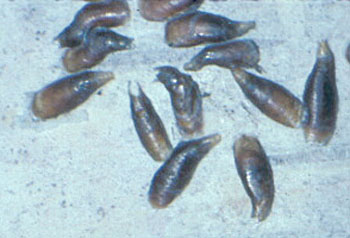Issue 4, May 21, 2018
Oystershell Scale
Oystershell scale (Lepidoasaphes ulmi) can be a tricky species to control without understanding their life cycle and biology. Adults are small, about 2 – 3 millimeters long and can be gray or brown. They can be easily differentiated from other scale insects by the oyster shell shaped scale that covers their bodies. When the females lays eggs, they overwinter beneath her protective scale. The young crawlers hatch, emerge from the protective scale and become active from May through June. When crawlers choose a location to settle, they pierce the plant with their straw-like mouth parts and suck fluids from the plant. Fluid feeding can result in leaf yellowing, leaf or twig stunting and, in some cases, plant death. Heavy infestations can also result in die back of the affected twigs and the stress can leave the plant more susceptible to wood-boring insects.

Oystershell scale.
This is a pest with a broad host range, including ash, birch, crabapple, dogwood, elm, maple, poplar, walnut and willow. They often clusters together, heavily infesting individual branches on a tree or shrub rather than evenly distributing themselves among all of the branches. This can result in twigs and branches that are encrusted with adult scales.
Cultural practices like irrigation, fertilization and mulching can help reduce plant stress and allow plants to better withstand scale feeding. However, large scale populations may require insecticides for effective management. When that is the case, treatments should be applied when crawlers are present. Adults are not well controlled with pesticides because the products do not penetrate their protective scale. Crawlers are not always present on affected ornamental plants and when they are, their small size can make them difficult to find. Knowing when to scout and treat for this pest is the key to its control.

Oystershell scale crawlers.
There are two races of oystershell scales which differ in color and timing of activity. The timing of scouting and control can be determined based on degree-days or plant phenology. Brown race oystershell scale crawlers are present when 275 – 500 degree-days have accumulated (base 50) or when VanHoutte spirea (Spirea x vanhouttei) is in late bloom. Similarly, the gray race crawlers are present when 400 – 600 degree-days have accumulated (base 50) or when VanHoutte spirea has finished blooming. Many areas in Illinois are already moving into those degree-day ranges and are seeing spirea bloom so it is the perfect time to begin scouting for oystershell scale. Crawlers can be seen using a hand magnifying glass above the surface of a branch with visible adult scales or by placing two-sided tape around a branch and inspecting it for crawlers.
Some insecticides recommended for controlling oystershell scale crawlers include acephate (Orthene), carbaryl (Sevin), malathion, insecticidal soap and horticultural oil. If you struggle to identify crawlers and would prefer to control adults, oystershell scales can be mechanically removed from a plant. Twigs or branches that are heavily encrusted with scales can be easily pruned away from the plant, quickly knocking down a large portion of the scale population. (Sarah Hughson)
Author:
Sarah Hughson